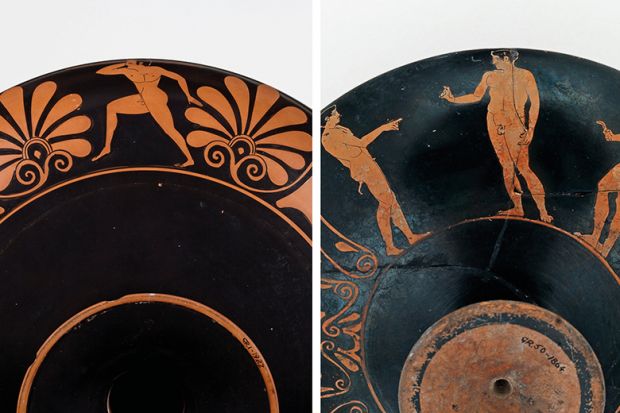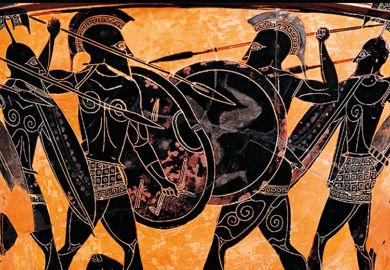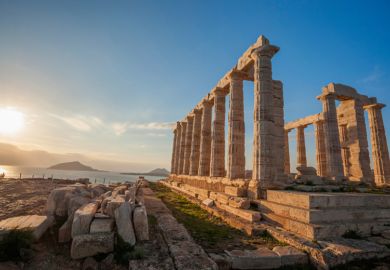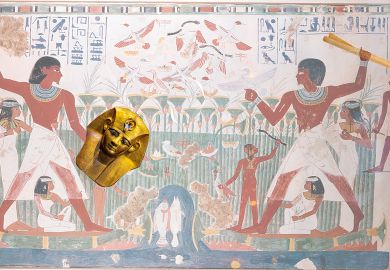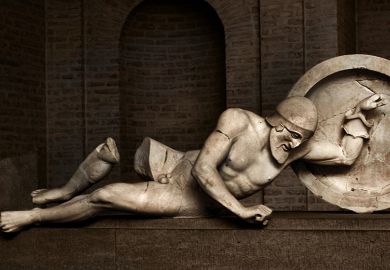To most modern viewers, all ancient Greek vases look the same. Yet Robin Osborne detects a need to explain “the way in which artists working in Athens changed their representational choices” between about 520 and 440BC. This opening declaration is illustrated by Plates 1 and 2, reproducing two cups dated 70 years apart: same shape, same colours (a red figure against a black background), same band of decoration around the outer rim, same subject of representation (athletes interspersed with very similar decorative motifs).
Osborne’s introduction offers no indication of what differences between the two plates we are supposed to spot, but readers who persevere find out and, indeed, develop a “period eye” through reading. In the course of six chapters, he juxtaposes red-figure vases depicting the same activity (athletics, war, courtship, sacrifice, drinking parties and the tomfoolery of satyrs), asking how representations change over time.
The answer is surprisingly coherent across activities: what changes, according to Osborne, is the way in which “the figures represented relate to one another on the pot”.
Early vases show people actively competing in athletics, fighting, having sex, sacrificing and revelling; whereas “individual performance is more or less systematically excluded from view” on the later ones. Athletes no longer throw the javelin or jump (as in Plate 1), but rather relax and chat to each other after competing (as in Plate 2). Rather than explicit sex scenes, late classical vases show people courting, or preparing for weddings in the company of friends. This last change has long been noted and discussed, but Osborne offers a new explanation: it is activity in general, rather than sexual activity per se, that becomes less popular as a subject of representation.
The next question is: why? Three concluding chapters answer this by combining political history with the history of art. What Osborne sees in the development of classical Athenian pottery is the emergence of “democratic” virtues. In terms of Greek history, the notion of a development from individualism to cooperation is not new: Osborne traces it back to his immediate predecessors and colleagues, but it was already outlined in the 19th century, by Friedrich Nietzsche, for example.
In terms of art history, Osborne occasionally overstates his own originality: I fail to see, for example, how Jan Bašant “hid” his study of democratic ideology and Greek pottery (the man published his work, after all, albeit in French).
Still, Osborne’s book is original and important, as is its advocacy of a shift away from questions of technique and influence (eg, black-figure v red-figure pottery, borrowed motifs, etc) towards attention to subject and manner of representation. Since, as Osborne points out, artists do not just depict reality but shape it, I venture one concluding thought. There is evidence that Athenian democracy was exceptionally strident and litigious: the “quieter virtues” of contemplation and collaboration Osborne identifies on late classical vases may have been an attempt, on the part of artists and their customers, to remind themselves of the importance of such virtues.
Barbara Graziosi is professor of Classics at Durham University and is currently working on a book about homecoming.
The Transformation of Athens: Painted Pottery and the Creation of Classical Greece
By Robin Osborne
Princeton University Press, 304pp, £41.95
ISBN 9780691177670
Published 28 February 2018
POSTSCRIPT:
Print headline: Amphora aren’t just Greek to me
Register to continue
Why register?
- Registration is free and only takes a moment
- Once registered, you can read 3 articles a month
- Sign up for our newsletter
Subscribe
Or subscribe for unlimited access to:
- Unlimited access to news, views, insights & reviews
- Digital editions
- Digital access to THE’s university and college rankings analysis
Already registered or a current subscriber?
